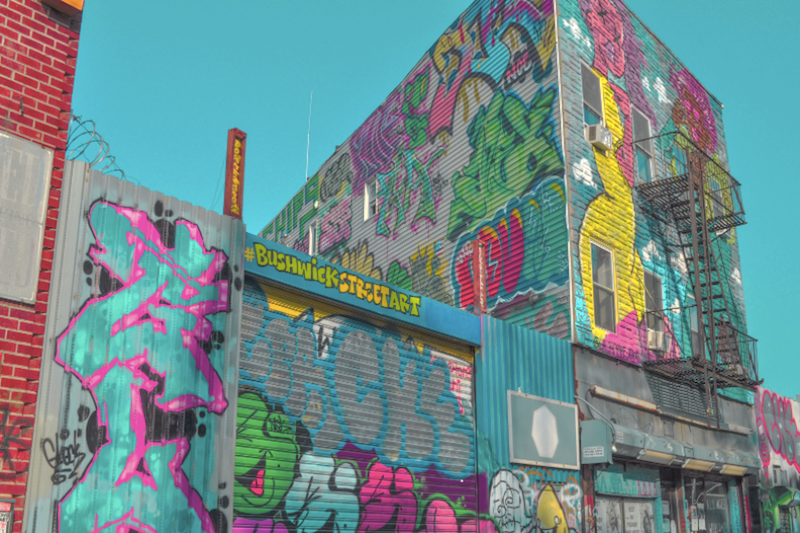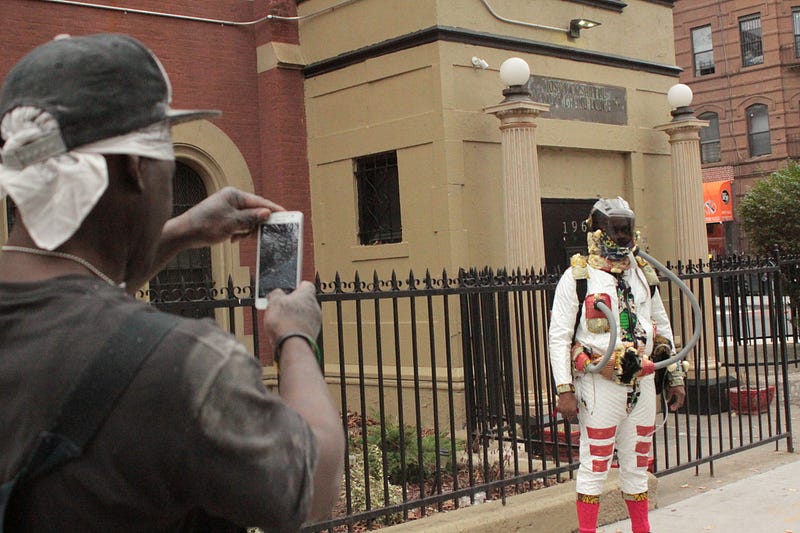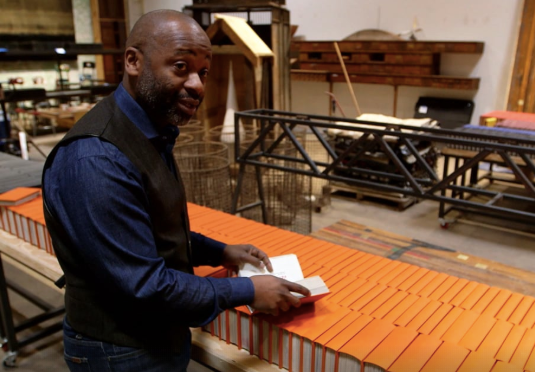
An interview with artist Salome Asega
As part of our series for the Collective Wisdom field study, we present this interview with Salome Asega, conducted by Katerina Cizek.
 Salome
Asega
Salome
AsegaAsega is a visual artist, and a technology fellow at the Ford Foundation in the Creativity and Free Expression program area. She has participated in residencies and fellowships at Eyebeam, New Museum, and the Laundromat Project, and has given presentations at New Inc, Performa, Eyeo, and the Schomburg Center. She received her MFA from Parsons at the New School in Design and Technology, where she also teaches.
How do you define co-creation in your field, in your work?
I’m very interested in multiplicity, multi-vocality, a kind of co-creation process that invites multiple people who have potentially differing perspectives to the same table.
What adjectives do you associate with co-creation? Are there fields that are cousins for you?
The first thing that immediately comes to mind is participatory action research. Participation, to me, is a synonym of co-creation.
In terms of your own work, what do you consider co-creative?
In my personal practice, I think a lot about institutional proximity and the ways I have been granted access to certain resources and ways I can leverage that access. I partner with community groups or subcultural movements — like dancers or particular music communities — to produce events. I’m always thinking about “How do I bring people into spaces?” Once I have an invitation, how do I extend that invitation?
And then also make the process as messy as possible. How do I make sure that everyone is learning how to use whatever technology we’re engaging with, be it Kinect — as I did with New Museum and Harlem Shake dancers — or Arduino and circuitry, as I did with the Double Dutch all-girls collective at Knockdown Center here in New York. I’m thinking about unusual partnerships and how to redistribute resources.
Can you elaborate a little bit on one or two examples?
In 2015, I had a residency with the New Museum in partnership with dancer and curator Ali Rosa-Salas, and another dancer, Chrybaby Cozie, a leader of Lite Feet Nation, a Harlem-based dance collective. The group is now international. We were having conversations about a dance craze called Harlem Shake; DJ Baauer made this song in 2012 that inspired viral dance videos of people shaking wildly in their offices and parks, wherever people gather.
Harlem Shake was an original dance from a music movement that was happening uptown in New York. So, when all these viral videos started popping up in 2012, the original dance form kinda disappeared. You’d have to go pages and pages into a YouTube search to find the original dance. And so we came together to ask, “How can we point to this digital erasure and teach people about the history of this dance?”
We came together at New Museum, and invited a bunch of Lite Feet dancers into the space. We tracked their shoulder movements using Kinect and used that as data for a game that taught you how to do the real Harlem Shake. Something like Dance Dance Revolution. In the final install, a participant would come up and push a big red shiny button and you’d launch into a minute-long instructional round with Chrybaby Cozie, where he teaches you the three fundamentals of the Harlem Shake: how to step, how to shake your shoulders. And then you go into a 30-second battle round against one of the Lite Feet dancers, and then you’re scored. Most people lost the game.
What I loved about that project is really the process of inviting Lite Feet dancers into a space where we had support to talk about and honor this dance style and collectively put it into game form — and then seeing it in final install and seeing people of all ages break the museum attendee performance where you’re slowly walking around and creating space between you and the work. With this install, people were dancing and being silly and learning too.
Since then, we’ve shown it at a couple different places, but it exists as a package of that time. The work itself may be interesting, but I think the conversations we had in the process are more important, more valuable.
How is it more valuable?
I think any moment where there’s a decision made is co-creating, where we’re learning collectively, challenging each other, adding nuance. A moment of dissensus is really a moment for realignment where we realize, “Hey, we’re not all on the same page.”
I really appreciate those moments because … How do I describe this? It’s like … When you are working collectively, I think you get really stuck on what you’re doing together without necessarily considering why you’re doing something together. So, when there’s a moment of conflict or dissensus, it’s a moment to talk about why we’re working together in the first place. That’s when you get into goals and strategies, and that stuff is much more exciting to me.
The moments of dissonance and tension are the ones that propel you forward in a way…. Can you elaborate on what documentarians or people working in emerging media might learn from the traditions of dance that perhaps are more co-creative inherently?
Well, I’m not a dancer, I’m not a choreographer. But something I appreciate about dance is that there’s always a fluidity in power between choreographer and dancer. You know, a choreographer will present an idea, but then a dancer interprets that direction and may take it somewhere else, and then it’s always a conversation between where the piece starts and where it ends up. That allows me, as a visual artist bringing some component to the piece, to also engage in that fluidity. There’s a lot of bouncing back and forth of ideas, and there’s something about dance that encourages you to add instead of just take direction.
How did you figure out the scoring on the game?
We mapped it against the data we were collecting during our open studio week where we invited dancers to come in and let us track them. We started somewhere in the middle with what we thought would be an okay score to have, and then we had people play and got their reactions. So, if people were not having fun because it was too difficult, we made it a little easier.
Did you get better as you practiced with the system?
No. This is embarrassing, but I am not a good Harlem Shaker. My score did not go up.
That’s funny. What do you think are the benefits of co-creation?
I think being able to see something from a new perspective is always generative. There are things I’ll miss when I come in as an artist with a certain vision for a project. When I invite someone new to the table, they’ll take it in a completely different direction sometimes, or they’ll affirm, but very rarely are people just affirming. They’re bringing in not only their own visioning, but also their own networks.
What are some historical examples of co-creation that have inspired you?
I think about how women in my family organize themselves. My family is Ethiopian and the entire block looks out for each other. I have a mother, but I also have six other mothers who live on the street and who can discipline me in the same way that my mom can. …We’re trying to build the best for everyone we care for in this community.
Do you have any projects that you admire?
In Marrakesh, there’s a night market that has an ongoing storytelling component that’s been going on for thousands of years — you come and you join and it’s a story. The whole idea is the circularity of storytelling: when you become the storyteller, the story becomes you, and you become the storyteller. It’s also about shared ownership and responsibility.
I’m excited by groups like Chinatown Art Brigade or collectives like BUFU, By Us For Us, or Yellow Jackets Collective. I love these young, newer collectives who are challenging institutional proximity, always asking their communities to be mindful of the ways museums and cultural spaces frame stories. They invite people to produce events with them in said cultural spaces as a way to decolonize them.
That leads to another question: How can co-creation be funded differently than current institutional funding models, and how might we also consider evaluation a different way?
Later today, I’m going to learn about this new platform called With Friends that is providing an alternative funding model for arts spaces, cultural spaces that aren’t necessarily 501(c)(3) or may be too small for traditional funding strains. They’re providing sliding scale memberships that offer discounted rates to the space’s future events. You could donate as little as a dollar a month and get 50% off the space’s tickets for events. It’s a brand new platform, but I’m really interested to see how community spaces that are struggling in New York can keep paying rent.
 Silent
Barn
Silent
BarnI think about Silent Barn. In 2012, they got a massive three-story building in Bushwick in Brooklyn and it was such a special place. They had music venues, there was a radio station in the back, there were artist studios and residences There were community organizations that held workshops in the space. And, then, like a lot of New York spaces — the rent got too high and they had to close. We’ve seen this story so many times and it becomes increasingly heartbreaking to see people build, build, build collectively in space together and then they can’t afford to be there anymore.
Some of the folks who started Silent Barn or were centered in that organizing work have started With Friends.
I’m really curious to hear your thoughts on the relationship between technology and co-creation.
It’s difficult because there is a learning curve. You can’t just ask people to jump into making unless you’re ready to provide a full 101 training. This is very important to me. I can’t make things with people using new technologies unless they also understand what’s happening because then, otherwise, I hold too much power in the making process.
There’s always a sense of urgency in production, but I would really like to slow down in my work because I want people to know what’s happening with technology and to have critical conversations. So, it’s not just about coding but understanding what it means. If, for example, in that game, if we’re collecting data, we should have critical conversations about what it means to collect the data, where does it go, how do we keep it safe.
Can you tell me about some of the challenges that you’ve faced with regards to co-creation?
I have a project called Iyapo Repository that I do in collaboration with another artist, Ayodamola Okunseinde, and two other artists assist us, Haja Jalloh and Mala Kumar.
Iyapo Repository is a resource library that exists in a nondescript future and collects arts and artifacts made by and for people of African descent. The project was started as an Eyebeam residency in 2016. It’s a speculative museum space that floats from residency space to exhibition space, wherever we’re invited to install.
 From Iyapo
Repository
From Iyapo
RepositoryThe way we generate the art and artifacts in the collection is through a series of participatory workshops. We partner with community groups in the host cities. We have a card game that gets people to think about the future in different domains, such as health, music, fashion. And then they generate future artifacts. They write work descriptions. We do some of the initial prototyping with participants during our workshop, and then we take these drawings back to the studio and use them to build fully functioning devices, artifacts.
The project has gone through so many iterations. The first time we did workshops, we didn’t include the prototyping portion, and so it felt like taking someone’s idea and running back to the studio and making it. But when the piece was installed, we’d invite them back or send them photos of the piece fully realized, and it felt like they weren’t fully involved in a making process. That prompted us to introduce these three prototyping tracks to our workshop.
There is now a physical computing track where we give you an Arduino and some basic electronic components and some crafting material, and we quickly prototype your drawing. And then there’s a VR drawing track where we have a VIVE set up and Tilt Brush and you can draw your artifact in 3D space. And then we also have a digital fabrication track where we show people how to either 3D print or laser cut some component of their drawing. That’s been extremely helpful in our framing of what participation and co-creation actually means.
Initially, before we had the cards, we were just having conversations with people about the future, and then through conversation, developing artifacts. But we realized there needs to be some scaffolding. People don’t think about the future without directions. So the cards provide prompts and scaffolding, but the conversation can go anywhere. We need the things to ground you, to give you a starting place.
Yeah, there’s a tension between keeping things open and having some structure in the design process. And how many places have you done the workshops now?
We have around 300 drawings. Each session, we have maybe about 15 to 20 people. We’ve gone to Pittsburgh, New York, Cambridge, Minneapolis, and DC.
What do you think the future of co-creation can be?
I think the future would be finding ways to get people who don’t live in the same place to work together seamlessly. Working over email or broken Skype calls, you feel the distance. So, I think developing tools that really allow people to collaborate and feel like they’re in the same room would be great.
Do you feel like co-creation may suffer from a lack of legitimacy?
Interesting question! Because Iyapo Repository is participatory, I feel like people are very quick to put us in an education bucket or a public programs bucket, not necessarily in a curatorial visioning or direction.
Or serious art.
Yeah. It’s really interesting seeing that happen with larger institutions where they’re like, “This would be great for a public program,” but not necessarily in the curated exhibition space. When there are more names attached to something, it feels more like a classroom or training. Maybe process is difficult to exhibit, but I don’t believe that’s true.
 Theaster
Gates
Theaster
GatesI think about artists who work with other people — like Theaster Gates or Rick Lowe or Mel Chen — who are all some of my favorite artists. Their practices are participatory and co-creative, but still, they get to exist as the singular artist.
We also are very concerned about the swarm, the dangers and risks of using a term like “co-creation,” or defining the practice. Do you have concerns in terms of co-optation?
Yeah, I worry sometimes about people strategically saying things are made with other people so they can check boxes — you know, be able to say that certain people were in the room. I’m worried about the ways that having an individual in the room turns them into a monolith for a particular gender or racial group.
This article is part of Collective Wisdom, an Immerse series created in collaboration with Co-Creation Studio at MIT Open Documentary Lab. Immerse’s series features excerpts from MIT Open Documentary Lab’s larger field study — Collective Wisdom: Co-Creating Media within Communities, across Disciplines and with Algorithms — as well as bonus interviews and exclusive content.
Immerse is an initiative of the MIT Open DocLab and The Fledgling Fund, and it receives funding from Just Films | Ford Foundation and the MacArthur Foundation. IFP is our fiscal sponsor. Learn more here. We are committed to exploring and showcasing media projects that push the boundaries of media and tackle issues of social justice — and rely on friends like you to sustain ourselves and grow. Join us by making a gift today.